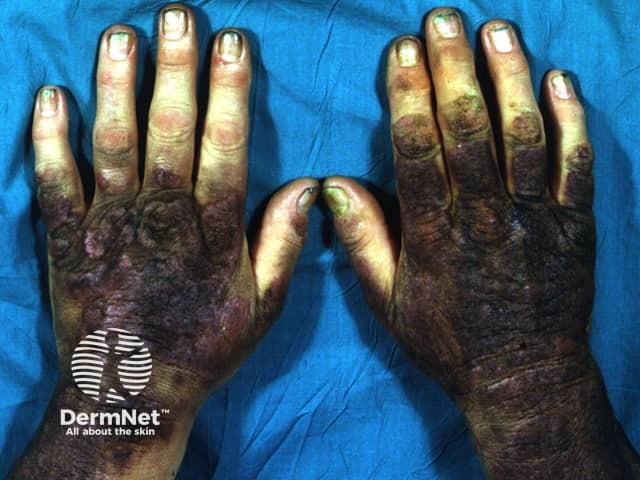Main menu
Common skin conditions

NEWS
Join DermNet PRO
Read more
Quick links
Coal tar or crude coal tar is obtained by the destructive distillation of bituminous coal at very high temperatures. It is believed that over 10,000 different compounds make up coal tar, but only 400 or so have been identified. The main groups of compounds making up crude coal tar are 48% hydrocarbons, 42% carbon and 10% water.
In its natural form coal tar is a thick, nearly black, viscous liquid with a characteristic smell. It is most often obtained in solution form (0.1 to 20%) and mixed with other ingredients, such as salicylic acid and sulphur, to make lotions, creams, ointments and shampoos. It has been used for decades to help treat the scaling, itching and inflammation of psoriasis, eczema, and other skin disorders.
Marketed preparations of coal tar in New Zealand include:
However, crude and refined coal tar preparations are still available through your pharmacist who will compound any coal tar preparation as prescribed by your doctor.
The use of coal tar is declining as newer compounds effective against the different forms of psoriasis are replacing it. However, it still has the advantages of being low cost and causing less systemic toxicity as compared with more modern therapies.
Coal tar is still used to treat a variety of skin disorders, particularly conditions where the skin is flaky and scaly.
Exactly how coal tar works to treat these conditions is not completely understood. It appears to have antimicrobial, antipruritic (reduce itching) and keratoplastic (normalise keratin growth in the skin and reduce scaling) effects.



Coal tar may be compounded with other ingredients to make creams, ointments, paints, pastes, gels, soaps, solutions and shampoos. Follow closely the instructions on the label on how to use your coal tar preparation. Listed below are some general tips for using coal tar products.
The Goeckerman regime is the application of 1–10% crude coal tar and exposure to ultraviolet radiation (UV-B) for the treatment of chronic plaque psoriasis, and occasionally, other inflammatory skin diseases. Exact details vary according to the centre using the regime, which is now uncommon despite providing long duration of remission for some patients.
Most patients tolerate coal tar preparations well. It may initially cause mild stinging or skin irritation as your body gets used to the medicine. However, if this continues to stop using the preparation and see your doctor.
When used on the scalp, it may temporarily discolour bleached, tinted, light blond or grey hair. Coal tar also stains skin and clothing. The stain on the skin will wear off after you have stopped using the preparation.
Coal tar may cause photosensitivity, hence the need to stay out of direct sunlight when using these preparations. In some instances, your doctor may use the Goeckerman regimen, which is a combination of coal tar with UVB phototherapy. This has been found to be particularly successful in treating psoriasis.
There is some controversy over the carcinogenic (cancer-causing) potential of coal tar. In animal studies, it has been shown to increase the chance of skin cancer. However, in human studies, an increase in the incidence of cancers has not been found after 75 years of documented use.